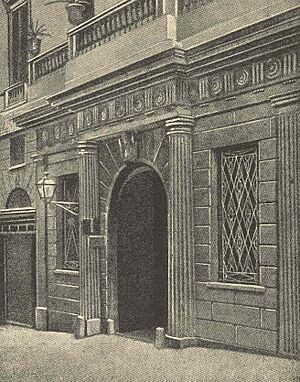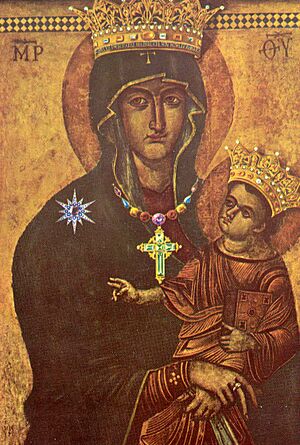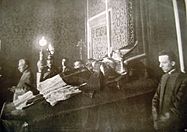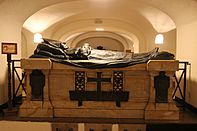Pope Benedict XV facts for kids
Quick facts for kids Pope Benedict XV |
|
|---|---|
| Bishop of Rome | |
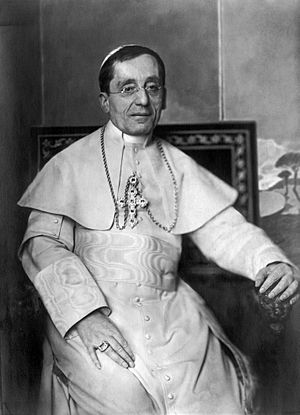
Portrait by Nicola Perscheid, 1915
|
|
| Church | Catholic Church |
| Papacy began | 3 September 1914 |
| Papacy ended | 22 January 1922 |
| Predecessor | Pius X |
| Successor | Pius XI |
| Orders | |
| Ordination | 21 December 1878 |
| Consecration | 22 December 1907 by Pius X |
| Created Cardinal | 25 May 1914 |
| Personal details | |
| Birth name | Giacomo Paolo Giovanni Battista della Chiesa |
| Born | 21 November 1854 Pegli, Genoa, Kingdom of Piedmont-Sardinia |
| Died | 22 January 1922 (aged 67) Apostolic Palace, Rome, Kingdom of Italy |
| Previous post |
|
| Motto | In Te Domine Speravi, Non Confundar In Aeternum (Latin for 'In thee, o Lord, have I trusted: let me not be confounded for evermore') |
| Signature | |
| Coat of arms |  |
Pope Benedict XV, born Giacomo Paolo Giovanni Battista della Chiesa (21 November 1854 – 22 January 1922), was the leader of the Catholic Church from 1914 until his death in 1922. His time as Pope was mostly shaped by World War I and its huge impact on Europe.
He became Pope at 59, right when World War I began. The war and its effects became his main focus. He quickly said the Holy See (the Vatican) would remain neutral. He tried to help make peace in 1916 and 1917, but both sides said no to his ideas. When diplomacy didn't work, Pope Benedict XV focused on helping people. He worked to care for prisoners of war, exchange wounded soldiers, and deliver food to people who needed it in Europe.
After the war, he helped improve relations with France, which started talking with the Vatican again in 1921. He also made relations with Italy better. He allowed Catholic politicians to take part in Italian national politics. In 1917, he released the Code of Canon Law, which are the rules for the Church. This new set of rules helped religious life around the world. He also worked to restart Catholic missions globally, earning him the nickname "Pope of Missions." He was very devoted to the Blessed Virgin Mary. Pope Benedict XV died on 22 January 1922, after seven years as Pope. He is remembered for his diplomatic skills and his openness to modern society.
Contents
Early Life
Giacomo della Chiesa was born early in Pegli, a town near Genoa, Italy, on 21 November 1854. He was the third son and sixth child of Giuseppe della Chiesa and Giovanna Migliorati. Because he was born early, Giacomo had a slight limp. He did much of his early schooling at home.
His father first didn't want him to become a priest. He wanted Giacomo to study law. At 21, Giacomo earned a law degree on 2 August 1875 from the University of Genoa. After getting his law degree, he again asked his father for permission to study for the priesthood. His father agreed, but insisted he study in Rome, not Genoa.
Della Chiesa went to the Collegio Capranica in Rome. In 1878, Pope Pius IX died, and Pope Leo XIII became the new Pope. Giacomo was ordained a priest by Cardinal Raffaele Monaco La Valletta on 21 December 1878. From 1878 to 1883, he studied at the Pontifical Ecclesiastical Academy in Rome. He joined the Vatican's diplomatic service in 1882. He worked as a secretary for Mariano Rampolla, who later became the Vatican's Secretary of State. Giacomo helped solve a disagreement between Germany and Spain over some islands. He also helped organize aid during a cholera outbreak.
Life in Bologna
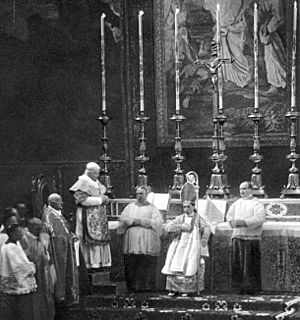
Becoming Archbishop
Giacomo della Chiesa became the Archbishop of Bologna on 18 December 1907. Pope Pius X himself performed the ceremony. Bologna was a large area with many people and priests. As archbishop, he visited all the churches, even small ones in the mountains that he had to reach by horse. He believed that preaching was the most important job for a bishop. He often gave two or more sermons a day. He also made sure churches were clean and that money was saved to help the poor.
Becoming Cardinal
It was common for the Archbishop of Bologna to become a cardinal. But Pope Pius X made della Chiesa wait almost seven years. Finally, on 25 May 1914, della Chiesa became a cardinal. He was given the title of Cardinal-Priest of Santi Quattro Coronati.
When he tried to return to Bologna, there was a socialist uprising in Central Italy. This included strikes and damage to churches. Della Chiesa spoke about the Church's role during this time. He stressed the importance of neutrality, peace, and helping those who were suffering as World War I was about to begin.
Time as Pope
| Papal styles of Pope Benedict XV |
|
|---|---|
 |
|
| Reference style | His Holiness |
| Spoken style | Your Holiness |
| Religious style | Holy Father |
| Posthumous style | None |
Election as Pope
After Pope Pius X died, a meeting of cardinals, called a conclave, was held in August 1914. The cardinals knew that the war would be the biggest challenge for the new Pope. So, they needed someone with good diplomatic skills. On 3 September 1914, Giacomo della Chiesa was chosen as Pope, even though he had only been a cardinal for three months. He chose the name Benedict XV in honor of Pope Benedict XIV, who was also an archbishop from Bologna.
Because of a disagreement with the Italian government at the time, Pope Benedict XV did not appear on the balcony of St. Peter's Basilica after his election. He was crowned in the Sistine Chapel on 6 September 1914.
Working for Peace

Pope Benedict XV's time as Pope was mainly about World War I. His first official letter as Pope asked for the fighting to stop. His early idea for a general Christmas truce in 1914 was not followed.
The war and its effects were his main concern. He declared that the Vatican would be neutral. He tried to help make peace in 1916 and 1917. But both sides in the war said no to his ideas. Some in Germany thought the Pope was secretly on the side of the Allies. Some French politicians thought the Vatican's efforts were against France. Pope Benedict XV tried many times to get the sides to talk peace, but these efforts made him unpopular with those who wanted to keep fighting for total victory.
On 1 August 1917, Pope Benedict XV shared a seven-point peace plan. It suggested things like:
- Replacing fighting with fairness.
- Reducing weapons for everyone.
- Setting up a way for countries to solve problems peacefully.
- Allowing freedom on the seas.
- Not asking for money for war damages.
- Leaving occupied areas.
- Looking at everyone's claims fairly.
Some of his ideas later appeared in U.S. President Woodrow Wilson's "Fourteen Points" plan for peace in 1918. Even though his efforts didn't stop the war, his diplomatic work helped the Pope's standing in the world. It also set an example for later Popes who tried to bring peace.
Helping People
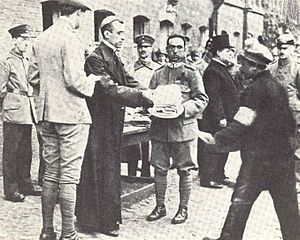
From the start of the war, Pope Benedict XV worked to exchange wounded and sick prisoners of war. Tens of thousands of prisoners were exchanged because of his help. In 1915, he helped exchange 20,000 civilians from occupied areas. In 1916, he helped 29,000 prisoners with lung disease from gas attacks go to Switzerland. He also helped prisoners with long captivity and many children go to neutral Switzerland.
He also helped get an agreement that prisoners of war would not have to work on Sundays and holidays. He saved several people from the death penalty. He set up an office to help share information about prisoners. By the end of the war, the Vatican handled about 600,000 letters about prisoners.
Pope Benedict XV was very concerned about children during and after the war. He asked people in the United States to help feed starving children in German-occupied Belgium. He also helped children in Lithuania, Poland, Lebanon, and Russia. He was very upset by aerial warfare (bombing from planes) and protested against it.
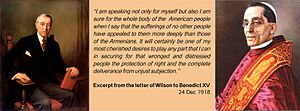
In 1915, the Ottoman Empire carried out a terrible act against the Armenian Christian people. The Vatican tried to get Germany and Austria-Hungary to protest to their Turkish ally. The Pope even sent a personal letter to the Sultan, but it did not succeed.
After the War
After the war, Pope Benedict XV focused on helping Europe recover from famine and hardship. He also worked to build relationships with the many new countries that formed after the war. The Vatican believed that the economic rules placed on Germany after the war were too harsh. They thought this could lead to another war later.
Pope Benedict XV also worried about the communist revolution in Russia. He was horrified by the anti-religious actions of the new government and the widespread famine. He made great efforts to help the victims of the Russian famine with millions in aid.
Church Activities
Canon Law Reform
In 1917, Pope Benedict XV released the Church's first full Code of Canon Law. This set of rules, which started in 1918, brought together all the Church's laws into one clear book. This new code helped to improve religious life and make rules clearer throughout the Church. He also helped Eastern Catholic traditions by starting an Oriental Institute in Rome.
Catholic Missions
On 30 November 1919, Pope Benedict XV asked all Catholics to support Catholic missions around the world. He said that these missions should respect local cultures and not just bring in European ways. He also stressed that missionaries needed to be well-prepared and learn local languages. He said that showing a good example was more important than just words.
Devotion to Mary
Pope Benedict XV was very devoted to the Blessed Virgin Mary. He encouraged people to pray to Mary and added the prayer Mary Queen of Peace to the Litany of Loreto. He also made 20 well-known Marian shrines into special churches called minor basilicas.
Personality and Appearance
Pope Benedict XV was a small man. He was known as "Il Piccoletto," which means "The Little Man." He was dignified and polite. He was famous for being very generous. He often gave large amounts of money from his own funds to poor Roman families. He also used a lot of the Vatican's money for charity during World War I. When he died, the Vatican's treasury was almost empty because of his giving.
He was careful about making changes in the Vatican. He would think about new ideas carefully before putting them into action. He believed in living in the present, not just in the past. He tried to have good relations with the Italian government, avoiding conflict. His neutrality during World War I was questioned by both sides, but he believed it was important.
Death

In early January 1922, Pope Benedict XV became ill with the flu, which turned into pneumonia. His health got worse on 19 January. He was given oxygen as breathing became difficult. On 21 January, he met privately with Cardinal Gasparri to share his last wishes. He passed away at 6:00 AM on 22 January 1922. After his death, flags were lowered to half-staff to honor him. His body was placed for people to see before being buried in the Vatican grottos.
Legacy
Pope Benedict XV made brave efforts to end World War I. In 2005, Pope Benedict XVI chose his name to show respect for his predecessor's commitment to peace. Pope Benedict XV's kind approach during the war was different from many other leaders at the time. His importance is shown by a tribute carved at the base of his statue in Istanbul, Turkey. It calls him "The great Pope of the world tragedy,... the benefactor of all people, irrespective of nationality or religion." This statue stands in the courtyard of the St. Esprit Cathedral.
Pope Pius XII had high regard for Benedict XV, who had made him a bishop. He praised Benedict XV as a man of God who worked for peace. He helped prisoners of war and many others in need. He was also very generous to Russia. He was also praised for his devotion to Mary and for the new Code of Canon Law.
Pope Benedict XVI also showed his admiration for Benedict XV when he became Pope in 2005. Choosing the name "Benedict" suggested that the new Pope wanted to continue Benedict XV's ideas about helping people through diplomacy and standing against certain modern ideas.
See also
 In Spanish: Benedicto XV para niños
In Spanish: Benedicto XV para niños
- Cardinals created by Benedict XV
- List of encyclicals of Pope Benedict XV
- List of meetings between the pope and the president of the United States
- List of peace activists
- List of popes


